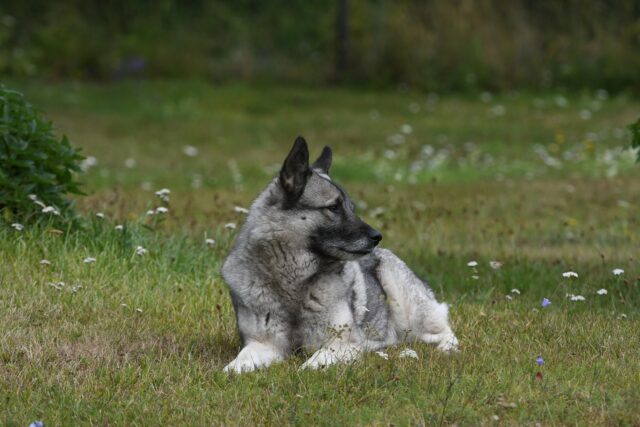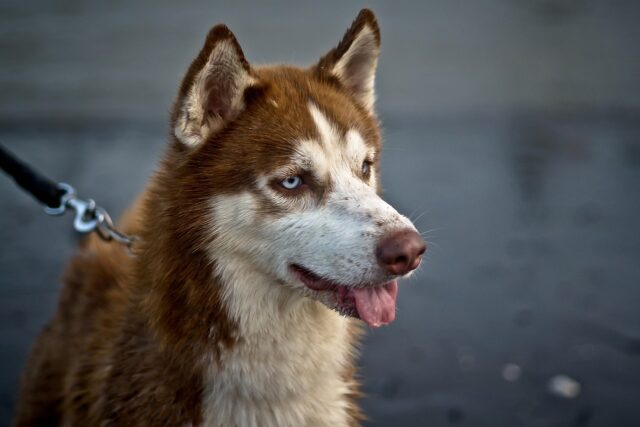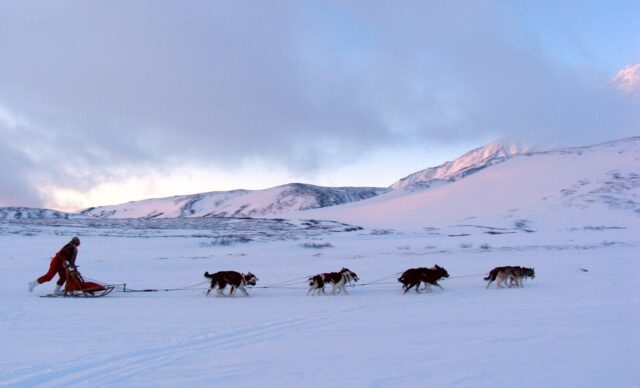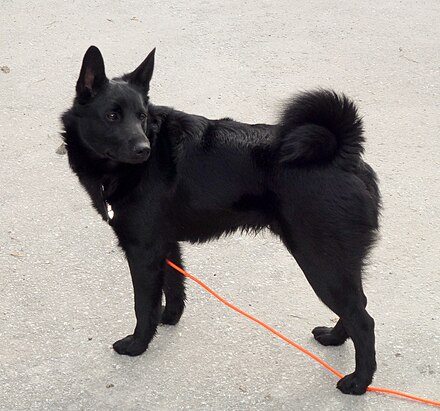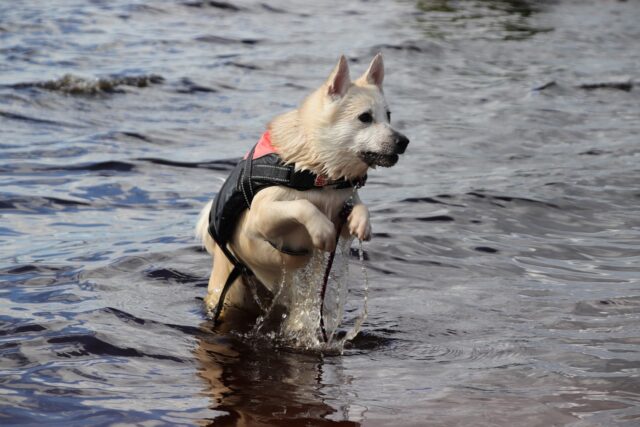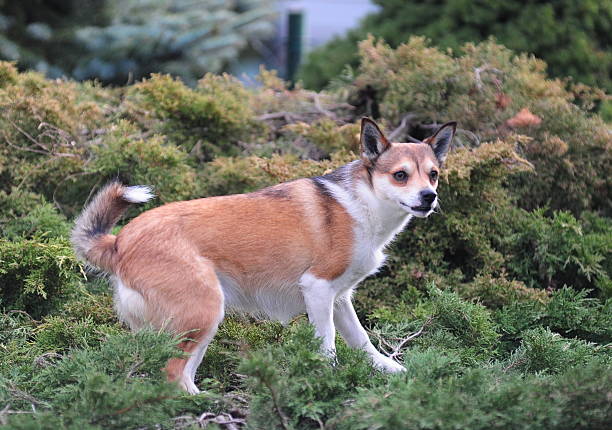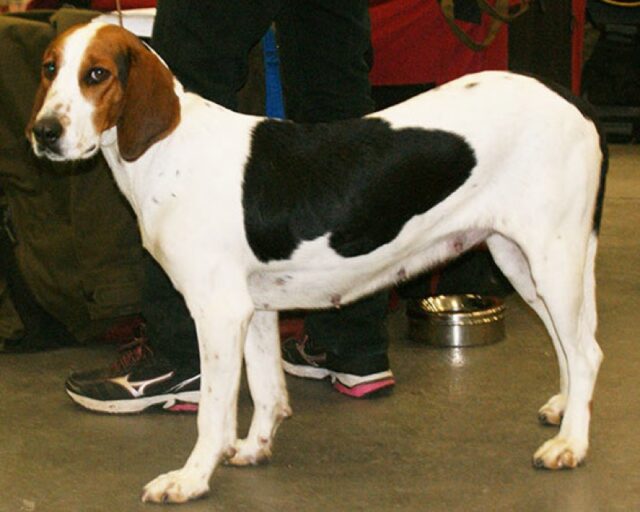By Fernando Villarreal
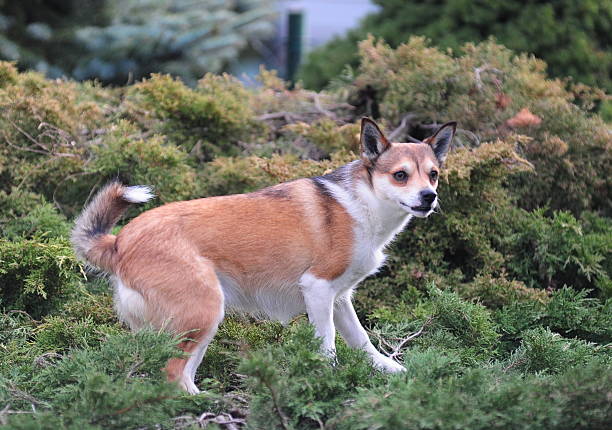
The Nordic Kennel Union (NKU) states that there are about 29 Nordic dog breeds, including the Samoiedskaïa Sabaka, also known as the Samoyed. This breed is common in Denmark, Sweden, Norway, Iceland, and Finland.
These Nordic dog breeds are renowned for their resilience, versatility, and companionship, making them popular choices among pet owners in the region. This blog will explore some of the most beloved Norwegian dog breeds, delving into their history, characteristics, and why they make such excellent pets.
Of these 29 breeds, 19 are hunting breeds. Today, we highlight the six most popular Norwegian breeds, many of which are Spitz-type breeds characterized by long, fluffy fur, pointed noses, and ears.
Originating from cold climates with harsh winters, these breeds have insulating coats to keep them warm. Most have tails that curve upwards and rest on their backs, while others have downward-curving tails.
Native to Norway, the Norwegian Elkhound and the Norwegian Buhund are two of the most well-known breeds. These dogs are a common sight in Norway, a testament to their resilience in the face of cold, harsh winters. Their ability to thrive outdoors in such conditions is truly remarkable.
Norwegian dog breeds excel in cold weather and enjoy sledding and rally obedience activities. Agility and canicross are also popular dog sports in Norway. Additionally, we explored insights from Norwegian Redditors to understand how people globally live with their dogs. Here’s what we found:
Different Breed Characteristics
If you’re looking at what breed characteristics differ from US dog breeds, Norwegian dog breeds have several distinctive features. Norwegian dog breeds, like the Norwegian Elkhound and Buhund, often display strong, resilient natures and are bred to withstand the harsh Nordic climate. These breeds are known for their sturdiness, thick coats, keen senses, and versatility in various roles, from hunting to herding.
Spitz characteristics, which include pointed ears, a dense fur coat, and a curled tail, are typical of Norwegian breeds. These traits are adaptations to cold environments and contribute to their alertness and agility.
In contrast to many American breeds, which may be bred more for companionship or specific tasks like retrieval or scent work, Norwegian breeds often retain a closer link to their ancestral roles as hunters and guards in rugged terrains.
What Redditors Say About Pet Culture in Norway
“Norway is very dog-friendly, especially outside the larger cities. You have almost unlimited possibilities to walk, run, and play with your dogs because of “allemannsretten,” which gives you permission to walk most places without having to find and get permission from the landowner. Some restrictions apply, but it’s generally awesome for dog owners.”
We looked at what Redditors had to say about pet culture in Norway. One Redditor explained that it is illegal to breed and train dogs to guard in Norway or to import dogs with such training (Dog Law § 19) and that barking dogs are not a thing in Norway because dogs are companions, not guard dogs.
Someone also mentioned that it was illegal to neuter your dog in Norway unless it was for health reasons. Another Redditor adds that dogs are not allowed in many places, and this is not a place for dogs.
Norway boasts a vibrant canine sports community where dogs and their owners actively participate in activities that showcase these remarkable animals’ athleticism, intelligence, and teamwork.
Dog sports in Norway encompass a wide range of disciplines that cater to different breeds and interests. Here are some famous dog sports in Norway:
Agility
Agility competitions are widely popular in Norway, where dogs navigate obstacle courses with speed and precision, guided by their handlers’ cues. This fast-paced sport tests the dog’s agility and strengthens the bond between the dog and its owner.
Sled Dog Racing
Given Norway’s snowy landscapes and historical connection to sled dogs, sled dog racing is a prominent sport in the country. Teams of dogs pull sleds through challenging terrain, showcasing their endurance, teamwork, and speed.
Tracking and Search
Norwegian dog enthusiasts often engage in tracking and search activities, where dogs use their keen sense of smell to locate hidden objects or track scents across varying terrains. These activities tap into dogs’ natural abilities and provide mental stimulation.
Obedience Trials
Obedience trials in Norway emphasize the dog’s ability to follow commands, demonstrate good behavior, and perform tasks precisely. Dogs and handlers work together to showcase discipline, responsiveness, and communication.
Herding Competitions
For breeds with herding instincts, herding competitions allow dogs to showcase their innate herding skills by maneuvering livestock through designated courses. These competitions highlight the working abilities and intelligence of herding breeds.
Nose Work Challenges
Nose work challenges involve dogs using their sense of smell to locate specific scents hidden in various environments. This activity taps into the dog’s natural hunting instincts and provides mental stimulation and a rewarding experience for the dog.
In Norway, dog sports keep dogs physically active and mentally engaged, fostering strong bonds between dogs and their owners. Norway’s thriving canine sports community reflects the country’s appreciation for dogs’ companionship, intelligence, and athleticism in various capacities.
Socialization
Socialization techniques for Nordic dog breeds are generally similar to those used for other breeds, but there are a few considerations to keep in mind due to their unique characteristics. Here are some key points:
- Start Early: Like all breeds, Nordic dogs benefit from early socialization. Introducing them to a variety of sights, sounds, and experiences when they are puppies helps them grow into well-adjusted adults.
- Positive Reinforcement: Use positive, reward-based training methods. Treats, toys, and praise are effective ways to encourage desired behavior. Avoid harsh criticism, which can be counterproductive.
- Regular Socialization: Consistent socialization is very important. Regularly exposing Nordic breeds to new environments and social situations can help them remain calm and well-behaved, which in turn helps to create a well-balanced, calm dog.
- Specific Considerations: Some Nordic breeds, like the Norwegian Buhund, may require early training to ensure proper socialization and prevent behavioral issues.
- Exercise Needs: Nordic breeds are typically active and intelligent, requiring plenty of physical and mental stimulation. Incorporate exercise into their socialization routine to keep them engaged and happy.
6 Most Popular Norwegian Dog Breeds
1. Norwegian Elkhound Black
Image Credit: Wiki
- Breed Name: Norwegian Elkhound
- AKC Recognition: Hound Group
- UKC Recognition: Northern Breed Group
- Height: Around 20 inches tall
- Lifespan: Typically 12 to 15 years
- Coat Color: Black
- Characteristics: Friendly, loyal, active, and alert
- Activities: Enjoys agility and herding trials
- Temperament: Initially reserved but becomes a steadfast companion
- Unique Traits: Sensitive soul with a hint of hound independence
The Norwegian Elkhound, a majestic breed known for its striking black coat and robust build, hails from Norway’s rugged landscapes. With their wolf-like appearance and sturdy stature, these dogs have a rich history as versatile working dogs and loyal companions.
Elkhounds are great friends and innovative protectors. They enjoy activities like agility and herding because they are active and eager to learn.
While they might initially seem shy, they will be your loyal buddy once they get to know you. Despite their confident nature, they are also quite sensitive and sometimes like doing things their way, just like a hound.
2. Norwegian Buhund
- Breed Name: Norwegian Buhund
- AKC Recognition: Herding Group
- UKC Recognition: Northern Breed Group
- Height: Approximately 17.5 to 18.5 inches tall
- Lifespan: Typically 13 to 15 years
- Coat Color: Wheaten or black
- Characteristics: Energetic, intelligent, versatile, and agile
- Activities: Excels in obedience and agility competitions
- Temperament: Sociable, intelligent, and enthusiastic
- Unique Traits: Known for their herding skills and friendly nature
Originating from Norway, these dogs have made a mark as excellent herders and versatile companions, showcasing their adaptability and intelligence. With their striking coat colors and a temperament that combines sociability with smarts, the Norwegian Buhund is a delight to have around.
From participating in obedience competitions to showcasing their agility in various trials, these dogs always impress with their eagerness to learn and perform. Their herding skills are unmatched, reflecting their historical role as valuable working partners to farmers and herders.
If you’re looking for a loyal, active, and intelligent canine companion, the Norwegian Buhund might be the perfect fit for your family.
3.Norwegian Lundehund
- Breed Name: Norwegian Lundehund
- AKC Recognition: Non-Sporting Group
- UKC Recognition: Northern Breed Group
- Height: Typically around 12 to 15 inches tall
- Lifespan: Average of 12 to 14 years
- Coat Color: Reddish-brown, tan, or gray
- Characteristics: Flexible, energetic, alert, and unique
- Activities: Particularly skilled in agility and scent work
- Temperament: Curious, independent, and friendly
- Unique Traits: Extra toes and incredible flexibility make them exceptional climbers and search-and-rescue dogs
Renowned for their climbing prowess on cliffs, the Norwegian Lundehund’s flexible joints enable them to navigate narrow passages effortlessly. Their unique abilities have earned them a special place in Norwegian hearts.
Originating from Norway, these dogs exhibit exceptional flexibility, making them stand out among other breeds. The Norwegian Lundehund is unique with its distinctive extra toes and agile nature.
Their keen curiosity, independence, and friendliness add to their charm, making them delightful companions for those seeking an adventurous and spirited canine partner. These dogs showcase their intelligence and versatility, excelling in agility and scent work, proving excellent competitors and reliable working dogs.
If you’re captivated by the extraordinary traits of the Norwegian Lundehund and are looking for a companion that brings a touch of uniqueness to your life, consider welcoming this exceptional breed into your home.
4. Halden Hound
Image Credit: Dog Zone
- Breed Name: Halden Hound
- AKC Recognition: Not explicitly recognized by the AKC; falls under the broader category of Hound breeds.
- UKC Recognition: Part of the Scenthound Group
- Height: Typically around 20 to 24 inches tall
- Lifespan: Generally 12 to 15 years
- Coat Color: Predominantly white with black and tan markings
- Characteristics: Loyal, gentle, friendly, trainable
- Activities: Suitable for hunting, agility, and companionship
- Temperament: Friendly, outgoing, and sociable; excellent family pet
- Unique Traits: Known for its keen sense of smell and strong hunting capabilities
Also known as the Haldenstover, this Norwegian dog breed is named after its country of origin, Halden. The Halden Hound’s exceptional scenting skills and hunting prowess make it indispensable in tracking game in Norway’s vast wilderness.
In Norway, people really like the Halden Hound. They are great at hunting and always stay close to their pet parents. Norwegian hunters rely on them to find animals in the harsh Norwegian wilderness because they have a good sense of smell and can move well in tricky places. The Halden Hound is known for its exceptional performance in various dog sports due to its agility, endurance, and keen scenting abilities.
5. Dunker
- Breed Name: Dunker
- AKC Recognition: Part of the Scenthound Group
- UKC Recognition: Northern Breed Group
- Height: Males typically 19½ to 21½ inches at the shoulder; females typically 18½ to 20½ inches.
- Lifespan: Typically 12 to 15 years
- Coat Color: Often marbled or harlequin pattern with blue or black patches on a white background.
- Characteristics: Loyal, robust, easy to train, and friendly.
- Activities: They are primarily used for hunting, particularly hares, but due to their versatility, they are also suitable for agility and companionship.
- Temperament: Known for being calm, gentle, and friendly, it makes an excellent family pet due to its friendly nature.
- Unique Traits: Distinguished by its excellent scent-tracking ability, it is a superb hunting dog.
The Dunker’s friendly demeanor and social nature belie their hunting heritage. This friendly breed thrives on human interaction, blending hunting instincts with warm companionship that wins hearts wherever it goes.
The Dunker breed is popular in Norway and the USA for several reasons. In Norway, the Dunker is celebrated for its historical significance as a versatile hunting companion that thrives in the country’s rugged terrain. The breed’s adaptability to diverse hunting conditions and loyalty have endeared it to Norwegian hunters for generations.
The Dunker’s popularity in the USA stems from its unique characteristics, including its friendly temperament, striking appearance, and proficiency in various dog sports. Dog enthusiasts in the USA appreciate the Dunker’s versatility as a family pet and a skilled working dog, making it a well-rounded choice for households seeking an active and affectionate canine companion.
6. Norwegian Elkhound Grey
Image Credit: Wiki
- Breed Name: Norwegian Elkhound
- AKC Recognition: Hound Group
- UKC Recognition: Northern Breed Group
- Height: Around 20 inches tall
- Lifespan: Typically 12 to 15 years
- Coat Color: Black
- Characteristics: Friendly, loyal, active, and alert
- Activities: Enjoys agility and herding trials
- Temperament: Initially reserved but becomes a steadfast companion
- Unique Traits: Sensitive soul with a hint of hound independence
This is a stunning breed, and if you’re a dog lover like us, you’ll be fascinated by this Norwegian dog breed. Standing about 20 inches at the shoulder and weighing up to 24 kg, the Norwegian Elkhound Grey is a picture of strength and agility. With a dense, silver-gray coat that provides insulation against the cold and protection in the wild, this terrific spitz-type dog breed is a medium-sized breed with a square-like confirmation.
Bringing a Norwegian Elkhound Grey into your life means embracing an active lifestyle. These dogs thrive on exercise and outdoor adventures, making them perfect partners for hiking, running, and other outdoor activities. Their intelligence and eagerness to please also make them highly trainable, though their independent streak calls for patience and consistency in training.
Nutrition, grooming, and regular veterinary care are essential to keep the Elkhound healthy and happy. Their thick coats require regular brushing to manage shedding and maintain their lustrous appearance.
As with any breed, understanding and meeting the physical and emotional needs of the Norwegian dog breeds is critical to giving the breed the right amount of outdoor exercise and mental stimulation necessary for these dog breeds from Norway.

